Alternative fruits
UK  Español
Español  Deutsch
Deutsch 
In a temperate zone like the UK you can grow a wealth of tasty fruits. However, all too often we limit ourselves to just a few well-known kinds, not realizing the vast wealth of other flavours we are missing. This section will look at some of these largely ignored fruits, with the hope of encouraging you to find space in your garden, allotment or whatever, where you will be able to grow and experience some of these flavours.
Although we are only going to look at the uncommon fruits that can be grown here, we would also strongly recommend that you grow a range of the more traditional crops. In fact you would be well advised to make sure that have planted at least some of the well known fruits before you even begin to consider some of the more unusual ones in this section.
So what are the fruits that we will not be looking at? Tree crops such as apples, pears, cherries and plums are discussed in all the many good books on fruit growing, as are the soft fruits such as raspberries, blackberries, red, white and blackcurrants, gooseberries, blueberries and strawberries. There are also several other fruits that are on the edge of their climatic tolerance here, but are none the less dealt with in most good books. These include grapes, figs, peaches and nectarines.
Having eliminated just about all the temperate zone fruits that most people are aware of, what is there left to talk about? A great deal, as I think you will agree after reading this section. All of the fruits we will be looking at here are, in general, of easy cultivation. Unless it says otherwise, they will be hardy in virtually all temperate zones, will succeed in most soils of reasonable fertility and will fruit best when grown in a sunny position, though will also do tolerably well in semi-shade. Almost all of them are trees or shrubs and so, with careful planning, it will be possible to grow various other crops with them in order to get better yields from the land and also to conserve and even improve fertility.
Most of the plants mentioned in this section will not have been selectively bred for heavier yields, or for flavour. None the less I think you will find that on the whole they will yield well, if not excellently, and, although individual tastes differ, it's likely that you will find at least some of the fruits mentioned here to be absolutely delicious. Another benefit of most of the plants mentioned here is that they are in general very hardy creatures and are less susceptible to pests and diseases. One of the problems in the past of selective breeding has been that, as we have selected for flavour and yield, so we have also unwittingly selected for plants that are less resistant to pests and diseases, and are also less tolerant of climatic extremes. Many of the plants mentioned below are much tougher creatures and will survive and fruit bountifully with very little attention from the grower.
- Actinidia species.
-
 All members of this genus of climbing plants produce edible fruits, though they do not all do well in temperate zones. The best known species is A. deliciosa, the Kiwi Fruit. This is widely sold in greengrocers, though not many people realize it can be grown here successfully, at least in the warmer parts of the country. If you want fruit that you can pick then you will need to prune the plants to keep them small - if left unpruned they will romp away and can grow to the top of trees 20 metres or more tall! There are two main difficulties with this crop. The first is that, although the dormant plants are quite cold-hardy, the young shoots in spring are very susceptible to frost damage. It is therefore best to grow them on a westerly aspect so that they are protected from the morning sun but still get plenty of warm sunshine. The second problem is that plants are usually either male or female, so you need to grow at least one male plant for every 4 - 5 females in order to get fruit. There are some cultivars that do not need a male for fertilization, though these are said to have inferior fruits. When grown from seed, the vast majority of seedlings are male, so it is best to buy named varieties. Heywood is the female form that is most commonly offered, though others can sometimes be found. Tomuri is said to be a good pollinator.
All members of this genus of climbing plants produce edible fruits, though they do not all do well in temperate zones. The best known species is A. deliciosa, the Kiwi Fruit. This is widely sold in greengrocers, though not many people realize it can be grown here successfully, at least in the warmer parts of the country. If you want fruit that you can pick then you will need to prune the plants to keep them small - if left unpruned they will romp away and can grow to the top of trees 20 metres or more tall! There are two main difficulties with this crop. The first is that, although the dormant plants are quite cold-hardy, the young shoots in spring are very susceptible to frost damage. It is therefore best to grow them on a westerly aspect so that they are protected from the morning sun but still get plenty of warm sunshine. The second problem is that plants are usually either male or female, so you need to grow at least one male plant for every 4 - 5 females in order to get fruit. There are some cultivars that do not need a male for fertilization, though these are said to have inferior fruits. When grown from seed, the vast majority of seedlings are male, so it is best to buy named varieties. Heywood is the female form that is most commonly offered, though others can sometimes be found. Tomuri is said to be a good pollinator.
Of the other species, probably the best to try in this country is A. arguta, the Tara Vine. This is even hardier than the Kiwi, its fruit is rather smaller but this is not covered with hairs and so can be eaten without peeling.
- Amelanchier species.
-
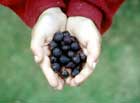 Although called Juneberries, the fruit actually ripens around the middle of July. This fruit is a bit smaller than blackcurrants, is sweet and juicy and has a definite flavour of apples. The main problem with this plant is that it is also a favourite fruit of the birds and so there is a bit of a race as to who gets there first.
Although called Juneberries, the fruit actually ripens around the middle of July. This fruit is a bit smaller than blackcurrants, is sweet and juicy and has a definite flavour of apples. The main problem with this plant is that it is also a favourite fruit of the birds and so there is a bit of a race as to who gets there first.
If you want to eat the fully ripe fruit then you will probably have to use some netting or other protective device. There are many species to choose from, our favourites include:-
Amelanchier alnifolia. This is a shrub that rarely grows more than 2 - 3 metres tall in this country and so is relatively easy to protect from the birds, and produces very sweet and juicy Juneberries. Once established, this plant will often produce suckers and can in time form thickets.
Amelanchier alnifolia semiintegrifolia is a very similar plant to the above, but with smaller fruits that ripen a week or two later.
Amelanchier laevis is a somewhat taller species that can reach 9 metres in height.
Amelanchier lamarckii grows up to 6 metres tall.
Amelanchier stolonifera. This is a relatively low-growing shrub, often no more than 2 metres tall. It can sucker quite freely, though only forms a slowly expanding clump. A very tasty fruit, vying with A. alnifolia as the favourite in this genus.
- Arbutus unedo
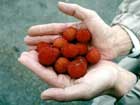 The Strawberry Tree is a delightful evergreen for the garden. The species can grow up to 9 metres tall, though there are cultivars that rarely go above 2 metres. The plant produces
The Strawberry Tree is a delightful evergreen for the garden. The species can grow up to 9 metres tall, though there are cultivars that rarely go above 2 metres. The plant produces
beautiful lily-of-the-valley type flowers in late autumn and is particularly eye-catching at this time since it is also ripening the fruit from the previous year’s flowering. These fruits do look rather like a strawberry, especially from a distance, but unfortunately do not taste like strawberries. Indeed, many people find them quite bland and the latin name unedo means “I eat one [only]” suggesting that they are not a worthwhile food. However, some people find them sweet and tasty, though they do have a rather gritty texture. But when you are getting a succulent fruit in winter you can forgive it a little grittiness. This plant does not do well in the colder parts of the country. It is surprisingly wind-tolerant, however, and grows well near the coast. If you want a dwarf variety, then look out for Compacta, Elfin King or Rubra.
- Berberis species.
-
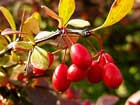 All members of this genus have edible fruits, though they tend to be rather acid in flavour and have rather too many seeds. Our native B. vulgaris used to be cultivated for its fruit, which ripens in late summer. There was a seedless cultivar, though it may not still be in cultivation. A deciduous shrub, it grows well in hedgerows, though it is considered a pest in cereal-growing areas because it is an alternate host for a disease of cereals.
All members of this genus have edible fruits, though they tend to be rather acid in flavour and have rather too many seeds. Our native B. vulgaris used to be cultivated for its fruit, which ripens in late summer. There was a seedless cultivar, though it may not still be in cultivation. A deciduous shrub, it grows well in hedgerows, though it is considered a pest in cereal-growing areas because it is an alternate host for a disease of cereals.
Of particular merit is B. darwinii. This evergreen shrub can grow to 3 or 4 metres tall and makes an excellent wind-resistant hedge, succeeding even in maritime areas. The fruit ripens in July-August and is adored by the birds. At first it is very acid, but if allowed to fully ripen it loses most of this acidity and has a lovely flavour.
- Cornus species.
-
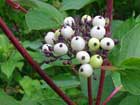 There are some wonderful fruits in this genus. C. masi, the Cornelian Cherry is a deciduous shrub that can reach 5 metres or more in height. It produces yellow flowers in midwinter and is particularly attractive at this time. The fruit ripens in late summer and needs to be fully ripe or it is very astringent. There is quite a degree of variability in size and quality of fruit. There used to be special cultivated varieties, but these may no longer exist. The fruits can get as large as 2cm long and 1.5cm wide. This species can also be grown as a hedge and is quite wind tolerant.
There are some wonderful fruits in this genus. C. masi, the Cornelian Cherry is a deciduous shrub that can reach 5 metres or more in height. It produces yellow flowers in midwinter and is particularly attractive at this time. The fruit ripens in late summer and needs to be fully ripe or it is very astringent. There is quite a degree of variability in size and quality of fruit. There used to be special cultivated varieties, but these may no longer exist. The fruits can get as large as 2cm long and 1.5cm wide. This species can also be grown as a hedge and is quite wind tolerant.
C. kousa, the Japanese Dogwood, is a deciduous tree that can grow up to 10 metres tall. It ripens its fruit in late summer, these are the size of very large strawberries and have a succulent flesh with an exquisite flavour. The skin is fairly soft and can be eaten with the fruit, but it does have a decidedly bitter flavour. Perhaps the best approach is to bite a small hole in the skin and then suck out the flesh. It is really like a luscious tropical fruit. The form most often found in gardens is C. kousa chinensis, this is said to grow and fruit better than the species, though maybe there isn't much difference.
- Crataegus species.
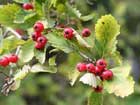 Hawthorns are one of the very best fruiting genera for temperate areas. There are many species with delicious fruits, the following are particularly recommended. In general the fruit is about the size of cherries and ripens in late summer:-
Hawthorns are one of the very best fruiting genera for temperate areas. There are many species with delicious fruits, the following are particularly recommended. In general the fruit is about the size of cherries and ripens in late summer:-
Crataegus arnoldiana. A tree that grows to 7 metres tall, the fruit is juicy and sweet.
Crataegus baroussana. A shrub to about 2 metres, the fruit is not quite as nice as the species above. This plant is probably only hardy in warmer temperate zones.
Crataegus douglasii. Growing up to 9 metres tall, the fruit is similar to C. arnoldiana.
Crataegus ellwangeriana. Up to 6 metres tall, with very similar fruit to C. arnoldiana.
Crataegus festiva. Growing 3 - 4 metres tall, the fruit is one of the best in the genus.
Crataegus pennsylvanica. A tall shrub to 9 metres tall, it always seems to produce heavy crops of very tasty fruits.
Crataegus schraderiana. A tree to 6 metres tall. When the fruit is fully ripe it almost literally melts in the mouth.
Crataegus tanacetifolia. Growing up to 10 metres tall, the fruit is yellow in colour and rather like a very rich apple in flavour.
- Diospyros species.
-
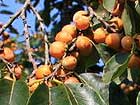 A genus of deciduous trees, the true Persimmon, D. kaki, is not a reliable fruiter in temperate climates, which is a shame since it is one of the most exquisite fruits it is possible to eat. However, the following species produce similar tasting, if much smaller, fruits:-
A genus of deciduous trees, the true Persimmon, D. kaki, is not a reliable fruiter in temperate climates, which is a shame since it is one of the most exquisite fruits it is possible to eat. However, the following species produce similar tasting, if much smaller, fruits:-
Diospyros lotus. The DATE PLUM grows up to 9 metres tall. The fruit does not often ripen on the tree, but if you either leave it on the ground when it falls in autumn, or harvest it and store it in a cool place such as a garage, it will continue to ripen. Don’t eat it until it is squidgy-soft or it will be harsh and astringent.
Diospyros virginiana. The American Persimmon can make a massive tree in its native range, though it seldom grows larger than 10 metres in this country. The fruit can be 2cm or more in diameter and is harvested and used in the same way as D. lotus.
- Elaeagnus species.
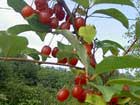 If you want to harvest a fresh fruit from your garden in spring, then this is the plant for you! The following species are especially recommended:-
If you want to harvest a fresh fruit from your garden in spring, then this is the plant for you! The following species are especially recommended:-
Elaeagnus cordifolia. A shrub growing to about 4 metres tall and wide, it is probably not hardy in the colder areas of the country. This produces the largest and earliest fruits.
Elaeagnus macrophylla. Grows about 3 metres tall and wide. Not hardy in the colder areas of the country. Selected cultivars have very good-sized fruits.
Elaeagnus x ebbingei. A very common hedging plant, it can
crop prolifically when given suitable conditions.
- Fuchsia species.
-
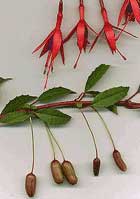 A genus of deciduous shrubs, though most of them are not very hardy and act more as herbaceous perennials in all but the mildest areas of the country. Fuchsia are commonly grown ornamentals, all of them produce edible fruits, though these often have a less than desirable aftertaste. Our favourite is F. splendens - but this is rather tender and will only succeed outdoors in the mildest areas of the country. It grows best in a shady position and does well even on a north-facing wall. It will succeed in full sun but can look rather burnt in such a position. The fruit is about the size and shape of a baby’s finger, it is soft and juicy with a very pleasant slightly acid flavour. If you cannot grow this plant in your area then there are many other hardier forms available. The best thing to do is to try some fruits from plants that you or your friends might already be growing. If you cannot find any you like, try getting hold of the cultivars Tresco or Globosa.
A genus of deciduous shrubs, though most of them are not very hardy and act more as herbaceous perennials in all but the mildest areas of the country. Fuchsia are commonly grown ornamentals, all of them produce edible fruits, though these often have a less than desirable aftertaste. Our favourite is F. splendens - but this is rather tender and will only succeed outdoors in the mildest areas of the country. It grows best in a shady position and does well even on a north-facing wall. It will succeed in full sun but can look rather burnt in such a position. The fruit is about the size and shape of a baby’s finger, it is soft and juicy with a very pleasant slightly acid flavour. If you cannot grow this plant in your area then there are many other hardier forms available. The best thing to do is to try some fruits from plants that you or your friends might already be growing. If you cannot find any you like, try getting hold of the cultivars Tresco or Globosa.
- Gaultheria shallon.
-
 An evergreen shrub to about 1.2 metres tall, it grows well in dappled woodland shade. The Shallon requires an acid soil, producing its fruit in the latter half of summer. This is about the size of a blackcurrant, it is pleasantly juicy though does not have a strong flavour. If you want a strong flavour then its diminutive relate, G. procumbens might be for you. Another plant for an acid soil and the dappled shade of woodland, it grows only 15cm tall and makes a good ground cover. The fruit ripens over a long period, fruits can be eaten from late summer round to late winter. These fruits are about the size of a large blackcurrant and have a very distinctive flavour that strongly resembles the Germolene of hospital waiting rooms! Surprisingly there are a number of people who really like this fruit, but perhaps it is acceptable only in small doses; it certainly leaves the mouth feeling clean and fresh.
An evergreen shrub to about 1.2 metres tall, it grows well in dappled woodland shade. The Shallon requires an acid soil, producing its fruit in the latter half of summer. This is about the size of a blackcurrant, it is pleasantly juicy though does not have a strong flavour. If you want a strong flavour then its diminutive relate, G. procumbens might be for you. Another plant for an acid soil and the dappled shade of woodland, it grows only 15cm tall and makes a good ground cover. The fruit ripens over a long period, fruits can be eaten from late summer round to late winter. These fruits are about the size of a large blackcurrant and have a very distinctive flavour that strongly resembles the Germolene of hospital waiting rooms! Surprisingly there are a number of people who really like this fruit, but perhaps it is acceptable only in small doses; it certainly leaves the mouth feeling clean and fresh.
- Hippophae salicifolia.
-
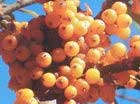 The Willow-Leaved Sea Buckthorn is a vigorous large deciduous shrub that suckers freely and so is not suitable for places where space is at a premium. A light-demanding species, it will not fruit well in the shade. A bacteria that lives on the roots fixes atmospheric nitrogen, so this is a plant that helps to fertilize the soil and to feed neighbouring plants. The fruit is only about 5mm in diameter and has a sharp lemon flavour. It cannot be eaten raw in any quantity, but makes an excellent juice, syrup or jam. Research has shown that this plant produces the most nutritious fruit yet discovered in temperate zones, regular use may prevent cancer, and large quantities have been shown to reverse the growth of cancer tumours. The fruit ripens in early autumn and hangs well on the plant - it can still be picked in late winter.
The Willow-Leaved Sea Buckthorn is a vigorous large deciduous shrub that suckers freely and so is not suitable for places where space is at a premium. A light-demanding species, it will not fruit well in the shade. A bacteria that lives on the roots fixes atmospheric nitrogen, so this is a plant that helps to fertilize the soil and to feed neighbouring plants. The fruit is only about 5mm in diameter and has a sharp lemon flavour. It cannot be eaten raw in any quantity, but makes an excellent juice, syrup or jam. Research has shown that this plant produces the most nutritious fruit yet discovered in temperate zones, regular use may prevent cancer, and large quantities have been shown to reverse the growth of cancer tumours. The fruit ripens in early autumn and hangs well on the plant - it can still be picked in late winter.
- Morus nigra.
-
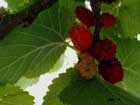 The Black Mulberry is fairly well known, but is all too rarely grown for its fruit. A deciduous tree, it can reach 10 metres in height but is usually smaller. The fruit ripens in late summer, it looks rather like a large raspberry, is very juicy and has a refreshing acid flavour.
The Black Mulberry is fairly well known, but is all too rarely grown for its fruit. A deciduous tree, it can reach 10 metres in height but is usually smaller. The fruit ripens in late summer, it looks rather like a large raspberry, is very juicy and has a refreshing acid flavour.
- Myrtus ugni.
-
.jpg) You are going to have to live in a very mild area of the country to enjoy this fruit, but it is one of Ken Fern's favourites. An evergreen shrub, it grows about 2 metres tall and wide and is reasonably wind-resistant. The fruit, which is a bit smaller than a blackcurrant, has a delicious aromatic flavour that has been described as a cross between a wild strawberry and a guava. Ken said 'No words can do justice to this fruit - you have to eat it to believe it. To us it is just ambrosia.'
You are going to have to live in a very mild area of the country to enjoy this fruit, but it is one of Ken Fern's favourites. An evergreen shrub, it grows about 2 metres tall and wide and is reasonably wind-resistant. The fruit, which is a bit smaller than a blackcurrant, has a delicious aromatic flavour that has been described as a cross between a wild strawberry and a guava. Ken said 'No words can do justice to this fruit - you have to eat it to believe it. To us it is just ambrosia.'
-
- Physalis peruviana.
-
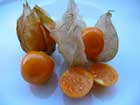 The Goldenberry is another plant for the milder areas of the country. An evergreen shrub in its native tropical environment, the leaves and shoots will be killed by the first serious frosts of autumn. However, the plant can be grown as an annual in much the same way as tomatoes, and in the milder areas of the country the roots will often survive the winter and send out new shoots in late spring. Applying a good mulch in the autumn will help here. The fruit is produced in its own paper bag, just like the Chinese lanterns to which it is related. When the fruit is fully ripe, these bags tun brown and dry. The fruit is golden yellow in colour, it is about 25mm in diameter, though it can vary considerably. It is somewhat tomato-like in flavour and appearance, though the taste is much richer with a hint of tropical luxuriance. The fruit starts to ripen in mid to late summer, late-ripening fruits can be stored in their bags for up to three months.
The Goldenberry is another plant for the milder areas of the country. An evergreen shrub in its native tropical environment, the leaves and shoots will be killed by the first serious frosts of autumn. However, the plant can be grown as an annual in much the same way as tomatoes, and in the milder areas of the country the roots will often survive the winter and send out new shoots in late spring. Applying a good mulch in the autumn will help here. The fruit is produced in its own paper bag, just like the Chinese lanterns to which it is related. When the fruit is fully ripe, these bags tun brown and dry. The fruit is golden yellow in colour, it is about 25mm in diameter, though it can vary considerably. It is somewhat tomato-like in flavour and appearance, though the taste is much richer with a hint of tropical luxuriance. The fruit starts to ripen in mid to late summer, late-ripening fruits can be stored in their bags for up to three months.
- Rosa rugosa.
-
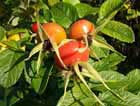 The Ramanas Rose is a fairly common hedge plant in temperate regions. A fast-growing and vigorously suckering deciduous shrub, it grows up to 2 metres tall. It is very tolerant of maritime exposure and of poor sandy soils. The fruit ripens from mid to late summer, it is deliciously sweet and has a very rich flavour. A rather fiddly fruit to eat, however, because there is only a fairly thin layer of fruit over a centre comprised of many seeds. It is important not to eat these seeds since they have small hairs on them and these can act as gastric irritants.
The Ramanas Rose is a fairly common hedge plant in temperate regions. A fast-growing and vigorously suckering deciduous shrub, it grows up to 2 metres tall. It is very tolerant of maritime exposure and of poor sandy soils. The fruit ripens from mid to late summer, it is deliciously sweet and has a very rich flavour. A rather fiddly fruit to eat, however, because there is only a fairly thin layer of fruit over a centre comprised of many seeds. It is important not to eat these seeds since they have small hairs on them and these can act as gastric irritants.
- Rubus species.
-
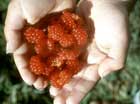 There are many members of this genus that are used for food. You probably already know blackberries, raspberries, loganberries and some of the many hybrid berries such as sunberries. There are a couple of less well-known species:
There are many members of this genus that are used for food. You probably already know blackberries, raspberries, loganberries and some of the many hybrid berries such as sunberries. There are a couple of less well-known species:
R. nepalensis, the Nepalese Raspberry, is a very low- growing evergreen shrub that makes an excellent ground cover. The plants seldom get taller than 20cm, but instead send out fairly vigorous ground-hugging stems that root at intervals as they scramble across the ground. Although the books say that the plant is only hardy in the milder areas, it is growing and fruiting at Cambridge Botanic gardens, which gets quite cold winters. The fruit is produced in mid to late summer. It is about two thirds the size of conventional raspberries and has a very nice acid flavour.
Another member of this genus worthy of attention is R. phoenicolasius, the Japanese Wineberry. A deciduous shrub, it can grow up to 3 metres tall. It has biennial stems in the same way as other raspberries, new stems being produced each year that flower in their second year and then die. The orange fruit is about 10mm in diameter and is produced in late summer. It is very juicy and has a very nice raspberry flavour. One very useful aspect of this fruit is that the plant very conveniently wraps up each developing fruit in the calyx of the flower, only unwrapping it as the fruit ripens. This does mean that the fruit is almost always maggot-free.
- Taxus baccata.
-
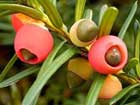 The Yew is a very slow-growing evergreen tree, it can eventually reach 15 metres in height though there are many smaller cultivars available. It is a very tolerant plant, growing in acid or alkaline conditions, in sun or shade (fruiting well even in fairly dense shade) and in windy positions. All parts of the plant are very toxic, except the sweet and juicy fruit. This ripens from late summer through the autumn. Most people who are willing to try this fruit find it delicious, though some are put off by its texture that is rather mucilaginous (or snotty to put it more bluntly). Be careful not to bite into the seed when eating this fruit - it is best to spit this out though it will do no harm if you swallow it whole. If you should accidentally bite into the seed (and you will immediately know by the bitter flavour in your mouth), then you should straight away spit it out to avoid any possibility of poisoning.
The Yew is a very slow-growing evergreen tree, it can eventually reach 15 metres in height though there are many smaller cultivars available. It is a very tolerant plant, growing in acid or alkaline conditions, in sun or shade (fruiting well even in fairly dense shade) and in windy positions. All parts of the plant are very toxic, except the sweet and juicy fruit. This ripens from late summer through the autumn. Most people who are willing to try this fruit find it delicious, though some are put off by its texture that is rather mucilaginous (or snotty to put it more bluntly). Be careful not to bite into the seed when eating this fruit - it is best to spit this out though it will do no harm if you swallow it whole. If you should accidentally bite into the seed (and you will immediately know by the bitter flavour in your mouth), then you should straight away spit it out to avoid any possibility of poisoning.
- We do hope this section encourages you to try growing at least some of them. For more details on the nutritional properties of fruits see the section: Fruit - Food of the Gods
Fruit - Food of the Gods
Database
The database has more details on these plants: Actinidia arguta, Actinidia arguta cordifolia, Actinidia arguta rufa, Amelanchier alnifolia, Amelanchier alnifolia cusickii, Amelanchier alnifolia semiintegrifolia, Amelanchier laevis, Amelanchier lamarckii, Amelanchier stolonifera, Arbutus unedo, Berberis darwinii, Berberis vulgaris, Cornus kousa, Cornus kousa chinensis, Cornus mas, Crataegus arnoldiana, Crataegus baroussana, Crataegus douglasii, Crataegus ellwangeriana, Crataegus festiva, Crataegus pensylvanica, Crataegus tanacetifolia, Diospyros kaki, Diospyros lotus, Diospyros virginiana, Elaeagnus cordifolia, Elaeagnus macrophylla, Elaeagnus x ebbingei, Fuchsia splendens, Gaultheria procumbens, Gaultheria shallon, Hippophae salicifolia, Morus nigra, Myrtus ugni, Physalis peruviana, Rosa rugosa, Rubus nepalensis, Rubus phoenicolasius, Taxus baccata.